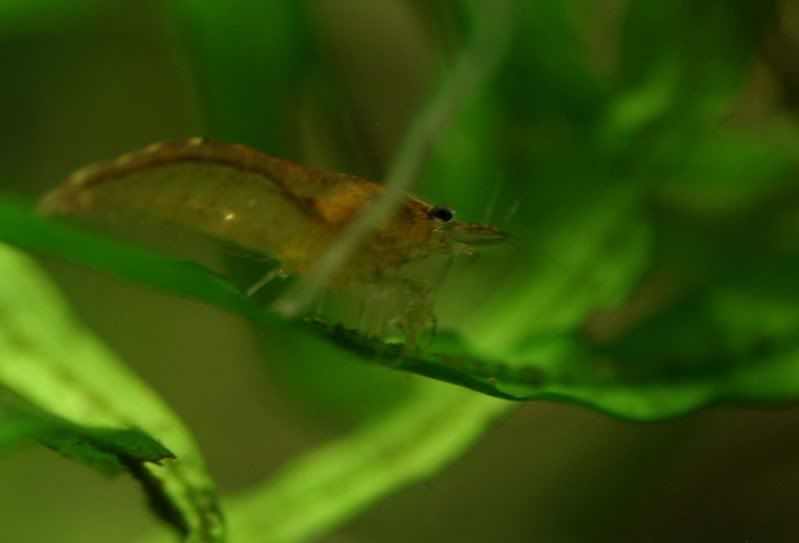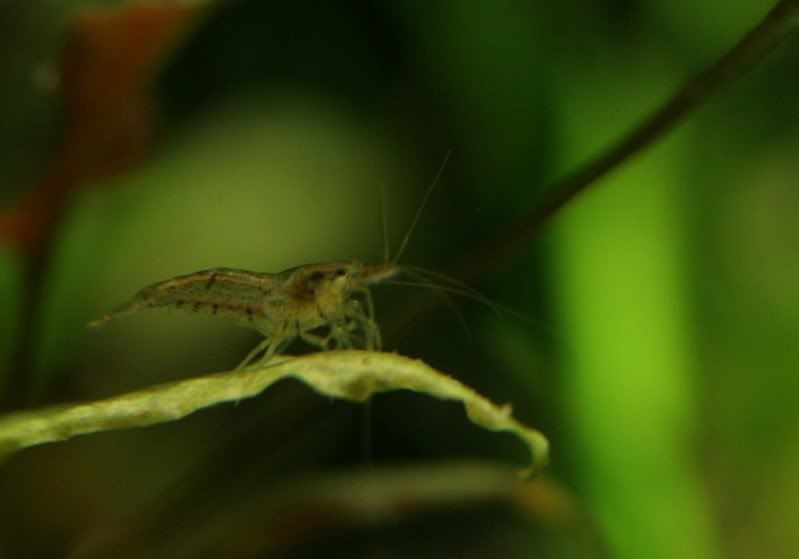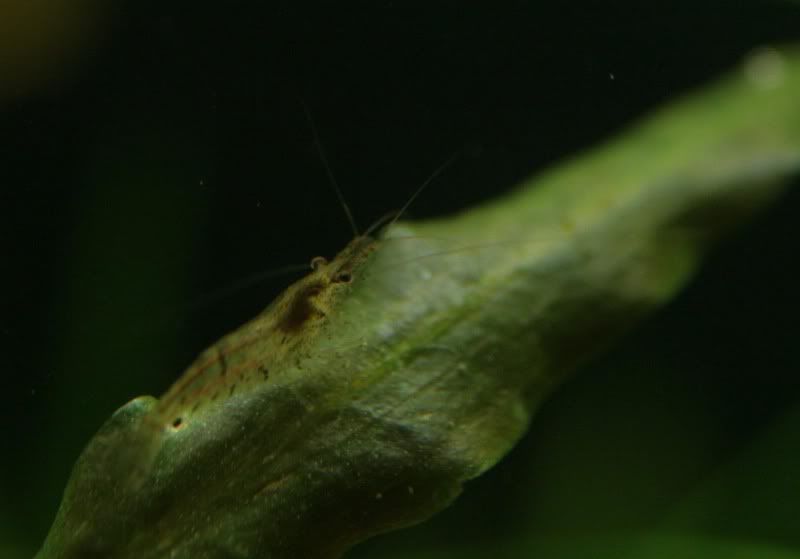Page 1 of 2
"Black shrimp"...possibly Neocaridina sp. 'blue'?
Posted: Sun Dec 10, 2006 11:48 pm
by Janthina
I recently found some shrimp at a LFS that were shipped in with an Asian order and probably wild-caught, labeled 'Black algae-eating shrimp'. Most of them are juveniles but i got some pics of the two larger specimens. Any ideas as to what they might be? Neocaridina sp. 'blue' is my first guess but i'd love to hear from those more qualified to determine such things.
Sorry about the poor image quality--they're very active and swim about far more than my other shrimp.
Thanks,
Cara



Posted: Mon Dec 11, 2006 4:59 am
by badflash
I don't know what they are, but I got a couple by mistake as well. I'm keeping them separated from my cherries just in case.
Posted: Mon Dec 11, 2006 8:58 am
by Mustafa
You have two different species on your pictures. The first one looks like what is imported under various names from India. The last two are juveniles of some kind of Neocaridina sp.
Posted: Sun Dec 17, 2006 2:57 pm
by badflash
I've only got 2, but as luck would happen, one is a female and one is a male. They both look like #2. She is now berried up with about 20 small eggs. The two shrimp spend all their time together. The males is much smaller than the female. I've been keeping them in the same conditions my as cherry shrimp but in a separate tank in case they would cross. Oddly enough I got one with a batch of amanos, and another with a batch of ghost shrimp.
Posted: Sun Dec 17, 2006 4:40 pm
by zapisto
it look like the shrimp i was trying to ident .
they grow now and i have offspring.
i can say they are not cherry with no color like some people told me , but definitively some sort of Neocaridina sp.
i m keeping them separated from my cherries just in case like badflash
mine look like the second pics.
Posted: Sun Dec 17, 2006 4:57 pm
by Neonshrimp
I have four that look like the one in the first picture. I am keeping it in basic tap water. They are very active and quick shrimp and change color to fit in with their surrounding. I have one that turns blue, black and light brown (just like the picture). I hope they can be ided soon

Posted: Sun Dec 17, 2006 5:57 pm
by badflash
Mine remain rootbeer colored and have those little slashes on them like pic #2.
Posted: Mon Dec 18, 2006 12:21 pm
by zapisto
Neonshrimp wrote:I have four that look like the one in the first picture. I am keeping it in basic tap water. They are very active and quick shrimp and change color to fit in with their surrounding. I have one that turns blue, black and light brown (just like the picture). I hope they can be ided soon

i hope too
i have now 6 berried female , and baby grow fast.
too bad i am not a good pics taker ,and all the friend who is good live far from me

i would add some more pics.
they are doing great and breed in alkalin/hard water
in soft and acidic water they grow faster , but nether breed.
i separate the group i had in two for this experiment, i lost some in acidic water , and non in alkalin water. il will start to have female from my first generation berried soon.
Posted: Mon Dec 18, 2006 4:28 pm
by Neonshrimp
Thanks for the great information about this shrimp. I hope you shrimp continue to reproduce as these are very active and interesting shrimp

As for me being a good picture taker, I would not know because I am still shopping for a camera. I would love to post pictures of my shrimp soon

!
your shrimp
Posted: Wed Feb 14, 2007 12:03 am
by aberfitch
I bout the exact same shrimp. I was very confused for a long while also and Looked and looked every on the web to figure out what the shrimp were. I origanaly wanted red cherry shrimp but they did not have any so I bought these guys. Did you ever figure out what type of shrimp these guys are? thanks!
Posted: Wed Feb 14, 2007 8:32 am
by pturley
edit
Posted: Wed Feb 14, 2007 10:01 am
by Neonshrimp
This species appears to be sexually dimorphic with the males more or less clear without the black markings on the tail.
Interesting shrimp

There is no better information than first hand experience.
Thanks.
Posted: Wed Feb 14, 2007 12:36 pm
by Janthina
I now have a growing flock/covey/school/herd of these little guys. However, all offspring resemble the second and third photo, with the thin black striations on their sides. I'm keeping these guys in moderately hard, alkaline water and they seem happy. They're not as colourful as my other shrimp but they're far more active, swimming around in the water column from plant to plant. To my eyes, they resemble the 2nd through 4th photos on the blue shrimp page...but i'll try to get more photos in the next week or two, and you can be the judge.
Cheers,
Cara
Posted: Wed Feb 14, 2007 3:57 pm
by Neonshrimp
To my eyes, they resemble the 2nd through 4th photos on the blue shrimp page...but i'll try to get more photos in the next week or two, and you can be the judge.
Good to hear that they are breeding and growing well for you. Looking forward to seeing the pictures.
Thanks for sharing.
Posted: Wed Feb 14, 2007 7:25 pm
by Mustafa
Trust me Paul, the shrimp in the above pictures are different species. It has nothing to do with sexual dimorphism. Even their rostra and body shapes are totally different. It takes quite a bit of experience with various species to recognize these differences right away, but I'm sure you'll get the hang of it eventually after gaining some more experience.
If you have the Indian species depicted on the first picture, then yes, the males are indeed clear (as is the case with most indian shrimp I have seen/kept), but the shrimp in the second and third pictures are 100% Neocaridina sp. and not males of the shrimp in the first picture. No doubt about it whatsoever.
And apparently, judging from Janthina's descriptions, only the Neocaridina sp. seem to have reproduced. Maybe there was no male for the Indian shrimp to fertilize her eggs.
Many stores keep all kinds of shrimp in the same tank, so it's not unusual that people get several species with a purchase.
pturley wrote:Mustafa wrote:
You have two different species on your pictures.
I have to disagree. This species appears to be sexually dimorphic with the males more or less clear without the black markings on the tail.
I have the same (or EXTREMELY SIMILAR) shrimp, including several mature offspring which show identical markings and same pattern of dimorphism.
Sincerely,
Paul E. Turley





